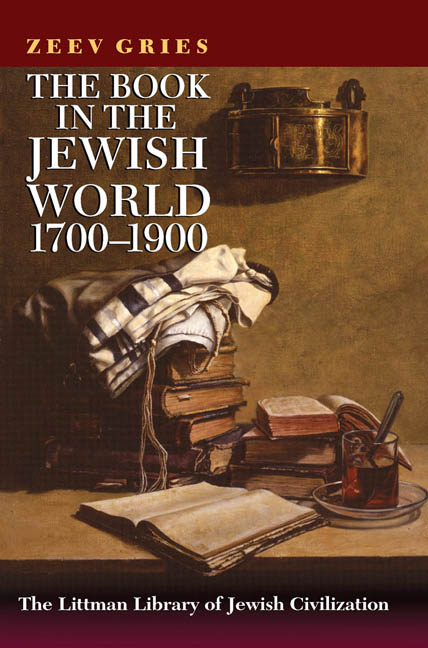Book contents
- Frontmatter
- Dedication
- Preface to the English Edition
- Contents
- List of Illustrations
- Note on Bibliographical Conventions and Transliteration
- Introduction
- PART I THE AWAKENING OF THE NASCENT INTELLIGENTSIA
- 1 Expanding Horizons
- 2 On Reading and Readers
- 3 Elite Literature: Halakhic Works and Textual Commentaries
- 4 Ethical Literature in Hebrew and Yiddish
- 5 On Libraries Private and Public
- 6 Kabbalistic Literature and its Role in Hasidism
- 7 Literature for Women and Children Only, or for Everyone?
- PART II THE BOOK: GUARDIAN OF THE SACRED OR HERALD OF SECULARIZATION?
- Afterword: The Revolution in the World of Hebrew Books at the Start of the Twentieth Century
- Appendix: The Young Abraham Ya'ari
- Bibliography
- Index of Books and Periodicals
- Index of Places
- Index of People
- Index of Subjects
7 - Literature for Women and Children Only, or for Everyone?
from PART I - THE AWAKENING OF THE NASCENT INTELLIGENTSIA
- Frontmatter
- Dedication
- Preface to the English Edition
- Contents
- List of Illustrations
- Note on Bibliographical Conventions and Transliteration
- Introduction
- PART I THE AWAKENING OF THE NASCENT INTELLIGENTSIA
- 1 Expanding Horizons
- 2 On Reading and Readers
- 3 Elite Literature: Halakhic Works and Textual Commentaries
- 4 Ethical Literature in Hebrew and Yiddish
- 5 On Libraries Private and Public
- 6 Kabbalistic Literature and its Role in Hasidism
- 7 Literature for Women and Children Only, or for Everyone?
- PART II THE BOOK: GUARDIAN OF THE SACRED OR HERALD OF SECULARIZATION?
- Afterword: The Revolution in the World of Hebrew Books at the Start of the Twentieth Century
- Appendix: The Young Abraham Ya'ari
- Bibliography
- Index of Books and Periodicals
- Index of Places
- Index of People
- Index of Subjects
Summary
THE IMAGE of the nascent intelligentsia as a kind of Sleeping Beauty, awakened by the magical kiss of the literature made available by enterprising printers and booksellers, has been a recurrent theme in this book. Despite the great importance of those genres of Hebrew literature—mainly ethical and kabbalistic works—that flourished during the eighteenth century and were read avidly in the great Jewish centres in Poland, it appears that the most powerful stimulus, culturally speaking, came not from Hebrew literature but fromYiddish literature.
The absence of Jewish printing from Poland for some hundred years from the mid-seventeenth century did not lessen the demand for books among the Jewish population there. As we have seen, this demand was met by printers in Amsterdam and elsewhere in the German-speaking lands. But the silencing of the Polish presses nevertheless had important consequences. First, the extensive changes in eastern Yiddish in this period, in consequence of the introduction of Slavic words and for unrelated reasons, were never recorded. Second, as Chone Shmeruk has correctly noted, the continued printing of Yiddish books in Germany preserved in print the language and style of western Yiddish literature, and it was these works that circulated in eastern Europe.
The books most frequently published in Yiddish were ethical works with stirring titles such such as Isaac ben Eliakim of Posen's Lev tov (A Good Heart) and Elhanan Kirchen's Simh. at hanefesh (Joy of the Soul), and books of popular exegesis and homily such as Tsena urena.Because they were published in Yiddish, which was the vernacular language, they were read by a much wider circle of readers than books in Hebrew;most certainly they were accessible to women in a way that Hebrew texts were not. As such they gave an eager public of women as well as men a taste of rabbinical legends and the teachings of medieval rabbis that stimulated their thirst for knowledge.Then, in the midseventeenth century, as Chava Turniansky has shown, this awakening took a more serious and critical turn. Even before that time, cultural entrepreneurs and translators had published books that combined commentaries on the Bible and popular midrashim (legends) in Yiddish; now, however, they started to translate the Bible itself into Yiddish. The publication of books in the old style, such as Tsena urena,did not cease, but there was a move towards translating the texts themselves.
- Type
- Chapter
- Information
- The Book in the Jewish World, 1700–1900 , pp. 91 - 100Publisher: Liverpool University PressPrint publication year: 2007

